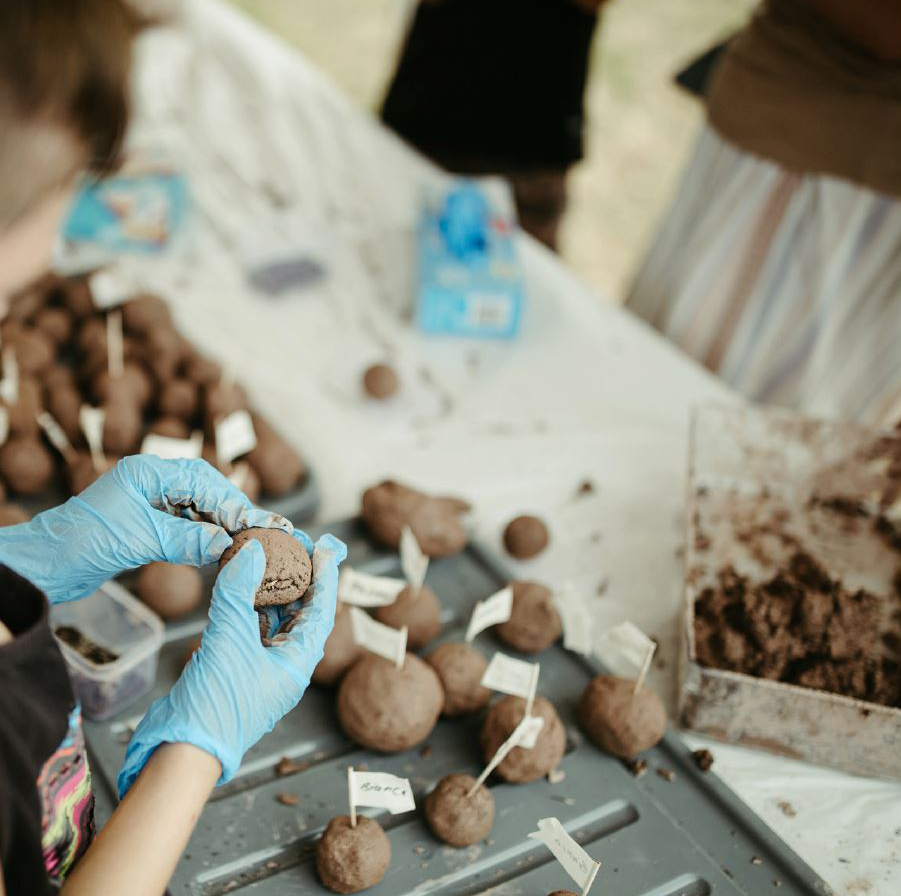May Contain Seeds
Wanting to design a functional project that both brought together communities and activated common spaces, the group of staff and students at School of Architecture and Built Environment (SABE) created an anti-mosquito interactive installation, along with a series of educational engagement workshops.

Central to their project, May Contain Seeds, is the seed bomb. Seed bombs are a powerful tool, typically used by ‘guerrilla gardeners’ to introduce plant life to inaccessible urban areas. The bombs are composed of a mixture of seeds, clay, and soil, which are moulded into pocket-sized balls which can be safely tossed over fences and out of windows. The seeds are carefully selected to suit the site-specific conditions across diverse microclimates, increasing the likelihood that they will germinate and grow.
As we all know, plants offer more to us than just decoration. They remove carbon from the atmosphere, enrich ecosystems to support diverse wildlife, and can help to stabilise soil: but the May Contain Seeds team also wanted to know if species of aromatic plants also act to reduce the activity of mosquitos on-campus. Mosquitoes are attracted to carbon dioxide, body odour, and heat – so the team hypothesised that the scent from aromatic plant species could decrease mosquito activity by confounding their senses.
Professor SueAnne Ware, Head of SABE, passed her seed of an idea onto University staff member Miranda Cunningham, who took the role of Project Lead in her stride.
The team put together a list of aromatic species which had been shown in the research literature to deter mosquitoes. May Contain Seeds then started its early life in Miranda’s backyard, where she experimented with different combinations of soil, clay, and her selection of aromatic seeds to see which recipes would best support the plants’ survival and growth.
They then brought together young adults and children through community workshops. These gave the participants an opportunity to actively participate in the program, learn more about ecosystems and the urban environment, as well as a chance to ask any questions they might have about the project overall.
To bring a sense of play to their place-activation scheme, May Contain Seeds wanted to store their seed bombs in brightly coloured gumball machines across campus. “That was actually one of the biggest challenges,” explains Miranda. “Finding the right sized machine, getting it delivered, and then working out how to fix it securely to the ground.” Regardless, the team managed to embed their bright and shiny new seed bomb dispenser (nicknamed, “Gumbo”) in a concrete slab, and bolt that to the ground right at home in their SABE courtyard.
At Gumbo’s launch, the team found a new way to test their aromatic plant hypothesis. They created their own repellents by filling spray bottles with water and blends of essential oils reflecting their selected seed bomb species. The sprays were indeed effective and are still in use by SABE staff and students on campus today.
Although the COVID-19 pandemic has put a slow to much of the foot traffic on campus, a couple of test sites are still active, and the team has been monitoring the growth of new species with great pride.
“It was a big challenge to get it all done in time,” says Miranda. “After all, you can’t control plants and you can’t control people! But I’d encourage people to give the Grand Challenge a go and just see what happens.”
The May Contain Seeds team consists of:
- Miranda Cunningham (Project Lead) (Staff and Alumni)
- SueAnne Ware (Staff)
- D’Arcy Newberry-Dupe (Staff and Alumni)
- Nicolas Flatman (Student and Alumni)
- Taona Afful (Staff and Alumni)
Wondering where the 2019 winners are now? Ask them anything at the upcoming AMA.
The University of Newcastle acknowledges the traditional custodians of the lands within our footprint areas: Awabakal, Darkinjung, Biripai, Worimi, Wonnarua, and Eora Nations. We also pay respect to the wisdom of our Elders past and present.